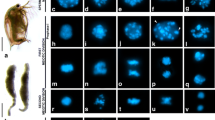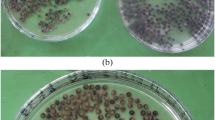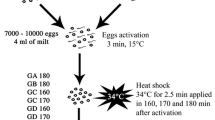Summary
-
1.
Sperm nuclei within activated eggs of the clam, Spisula solidissima were found to contain a normal haploid amount of DNA while sperm nuclei in inactivated eggs of the same clam contain significantly lower amounts of DNA.
-
2.
The DNA content of sperm nuclei within activated eggs increases to approximately the diploid amount during pronuclei formation whereas the DNA content of sperm nuclei in inactivated eggs does not show any increase.
-
3.
The amount of DNA in spermatozoa in the testis of Spisula varies from one clam to another. Some clams have predominantly the normal haploid amount of DNA while others show significantly lower amounts of DNA in the spermatozoa in the testis.
-
4.
The possible significance of the DNA content of spermatozoa for the activation process of the Spisula egg is discussed.
Similar content being viewed by others
References
Alfert, M.: A cytochemical study of oogenesis and cleavage in the mouse. J. Cell. a. Comp. Physiol. 36, 381–409 (1950).
Allen, R. D.: The use of Spisula solidissima eggs in cell research. J. Cell. a. Comp. Physiol. 37, 504–505 (1951).
— Fertilization and artificial activation in the egg of the surf-clam, Spisula solidissima. Biol. Bull. 105, 213–239 (1953).
Dalcq, A.: Les bases physiologiques de la fécondation et de la parthénogenèse. Paris: Presses Universitaires de France 1928.
Davidson, J. N.: The biochemistry of the nucleic acids. New York: John Wiley & Sons 1953.
Distefano, H. S.: A cytochemical study of the Feulgen nucleal reaction. Chromosoma 3, 284–301 (1948).
Hertwig, O.: Die Radiumkrankheit tierischer Keimzellen. Ein Beitrag zur experimentellen Zeugungs- und Vererbungslehre. Arch. mikrosk. Anat. 77, 1–165 (1911).
Hörstadius, S., L. J. Lorch and E. Chargaff: The effect of deoxyribonucleic acids extracted from sea urchin sperm on the development of sea urchin eggs. Exper. Cell Res. 6, 440–542 (1954).
Just, E. E.: The present status of the fertilizin theory of fertilization. Protoplasma (Wien) 10, 300–342 (1930).
Leuchtenberger, C.: A cytochemical study of pycnotic nuclear degeneration. Chromosoma 3, 449–473 (1950).
—: The nucleoproteins in cell growth and division. Statistics and mathematics in biology. Ames, Iowa: Iowa State College Press 1954.
—: Critical evalulation of Feulgen microspectrophotometry for estimating amount of DNA in cell nuclei. Science (Lancaster, Pa.) 120, 1022–1023 (1954a).
Leuchtenberger, C., F. Schrader, D. R. Weir and D. P. Gentile: The desoxyribosenucleic acid (DNA) content in spermatozoa of fertile and infertile human males. Chromosoma 6, 61–78 (1953).
Leuchtenberger, C., D. R. Weir, F. Schrader and R. Leuchtenberger: Abnormal amounts of desoxyribosenucleic acid (DNA) in germ cells of human males with suspected infertility. Excerpta med. 9, 418 (1954).
Lillie, F. R.: Problems of fertilization. Chicago: University of Chicago Press 1919.
Lillie, R. S.: Further experiments on artificial parthenogenesis in starfish eggs, with a review. Physiologic. Zool. 14, 239–267 (1941).
Loeb, J.: Artificial parthenogenesis and fertilization. Chicago: University of Chicago Press 1913.
Pollister, A. W.: Quelques méthodes de cytologie chimique quantitative. Rev. d'Hématol. 5, 527–554 (1950).
Rugh, R.: The X-irradiation of marine gametes. A study of the effects of X-irradiation at different levels on the germ cells of the clam, Spisula (formerly Mactra). Biol. Bull. 104, 197–209 (1953).
Runnström, J.: Membrane formation in different stages of cytoplasmic maturation of the sea urchin egg. Ark. Zool. (Stockh.), Ser. A 40, 1–6 (1948).
—: The mechanism of fertilization in Metozoa. Adv. Enzymol. 9, 241–327 (1949).
Sampson, M. M.: Sperm filtrates and dialyzates. Their action on ova of the same species. Biol. Bull. 50, 301–338 (1926).
Schrader, F.: Mitosis. The movements of chromosomes in cell division. New York: Columbia University Press 1953.
Stowell, R. E.: Feulgen reaction for thymonucleic acid. Stain Technol. 20, 45–58 (1945).
Swift, H. H.: The desoxyribose nucleic acid content of animal nuclei. Physiologic. Zool. 23, 169–198 (1950).
—: Quantitative aspects of nuclear nucleoproteins. Internat. Rev. Cytology 2, 1–76 (1953).
Tyler, A.: Artificial parthenogenesis. Biol. Rev. 16, 291–336 (1941).
Author information
Authors and Affiliations
Additional information
Postdoctoral Fellow of the National Cancer Institute, United States Public Health Service.
We wish to thank Professor Franz Schrader and Dr. Sally Hughes-Schrader of Columbia University, New York for their many helpful suggestions and discussions particularly in connection with the cytological aspects of this problem.
Rights and permissions
About this article
Cite this article
Ito, S., Leuchtenberger, C. The possible role of the DNA content of spermatozoa for the activation process of the egg of the Clam, spisula solidissima. Chromosoma 7, 328–339 (1955). https://doi.org/10.1007/BF00329731
Received:
Issue Date:
DOI: https://doi.org/10.1007/BF00329731




